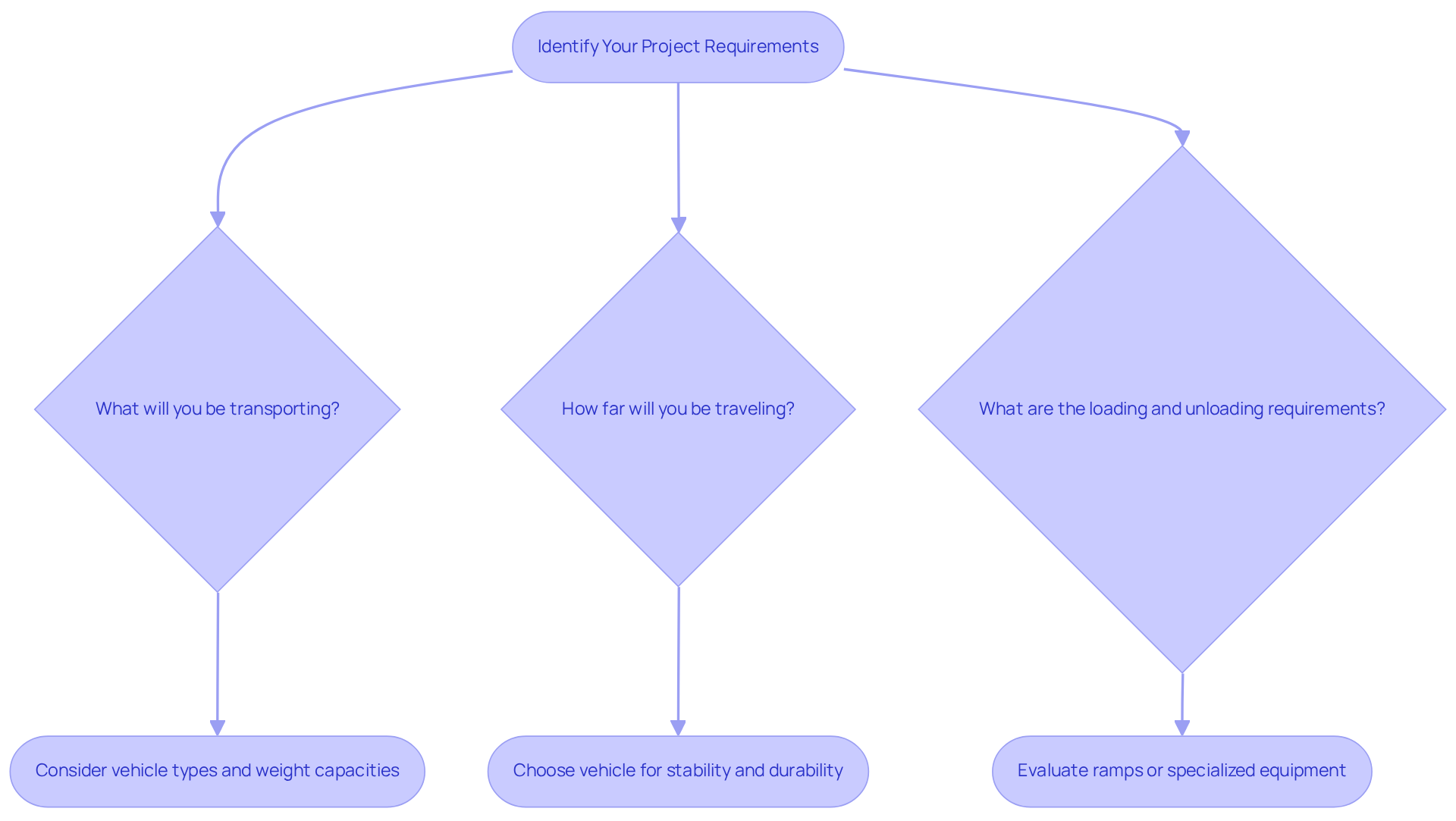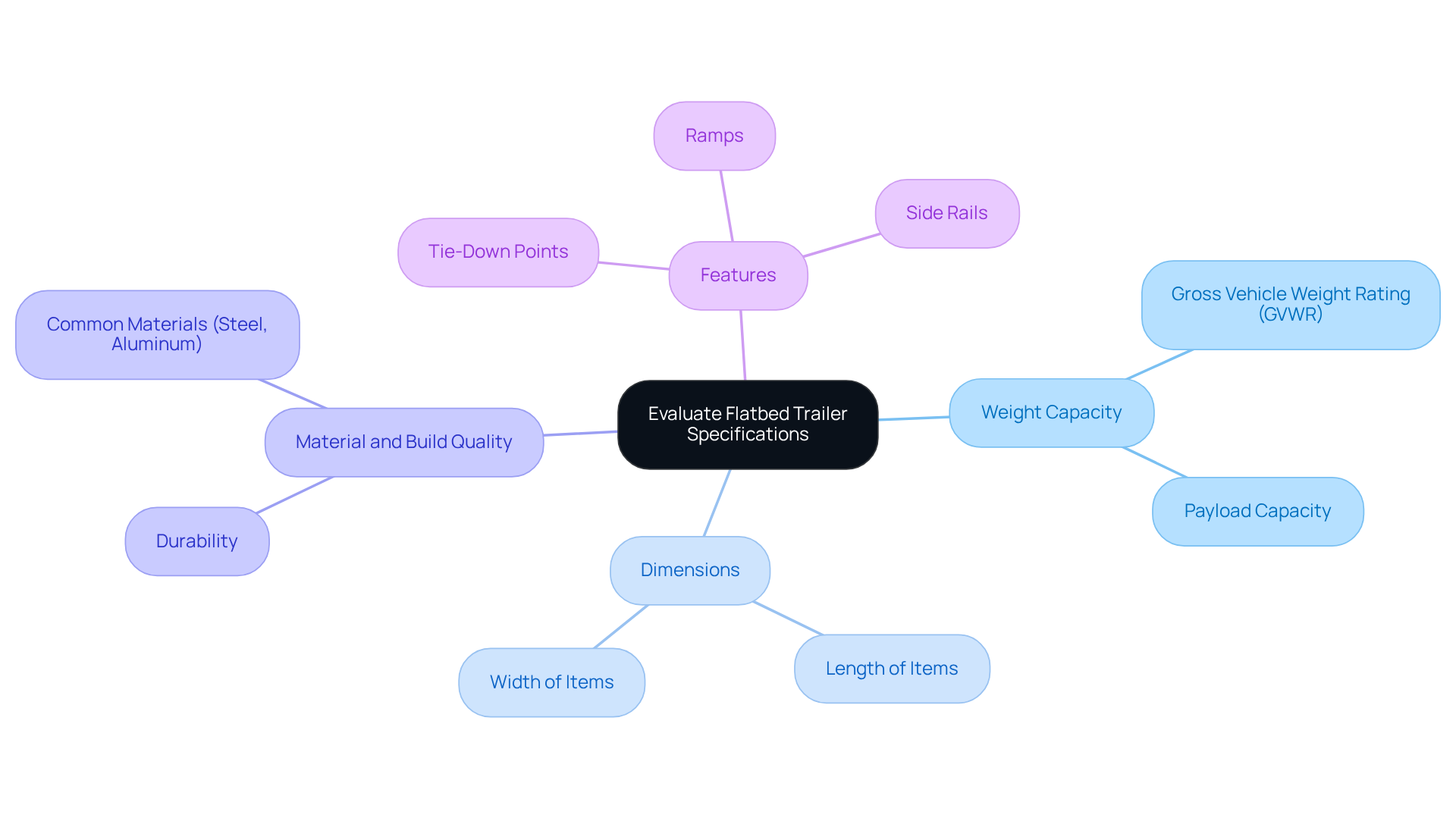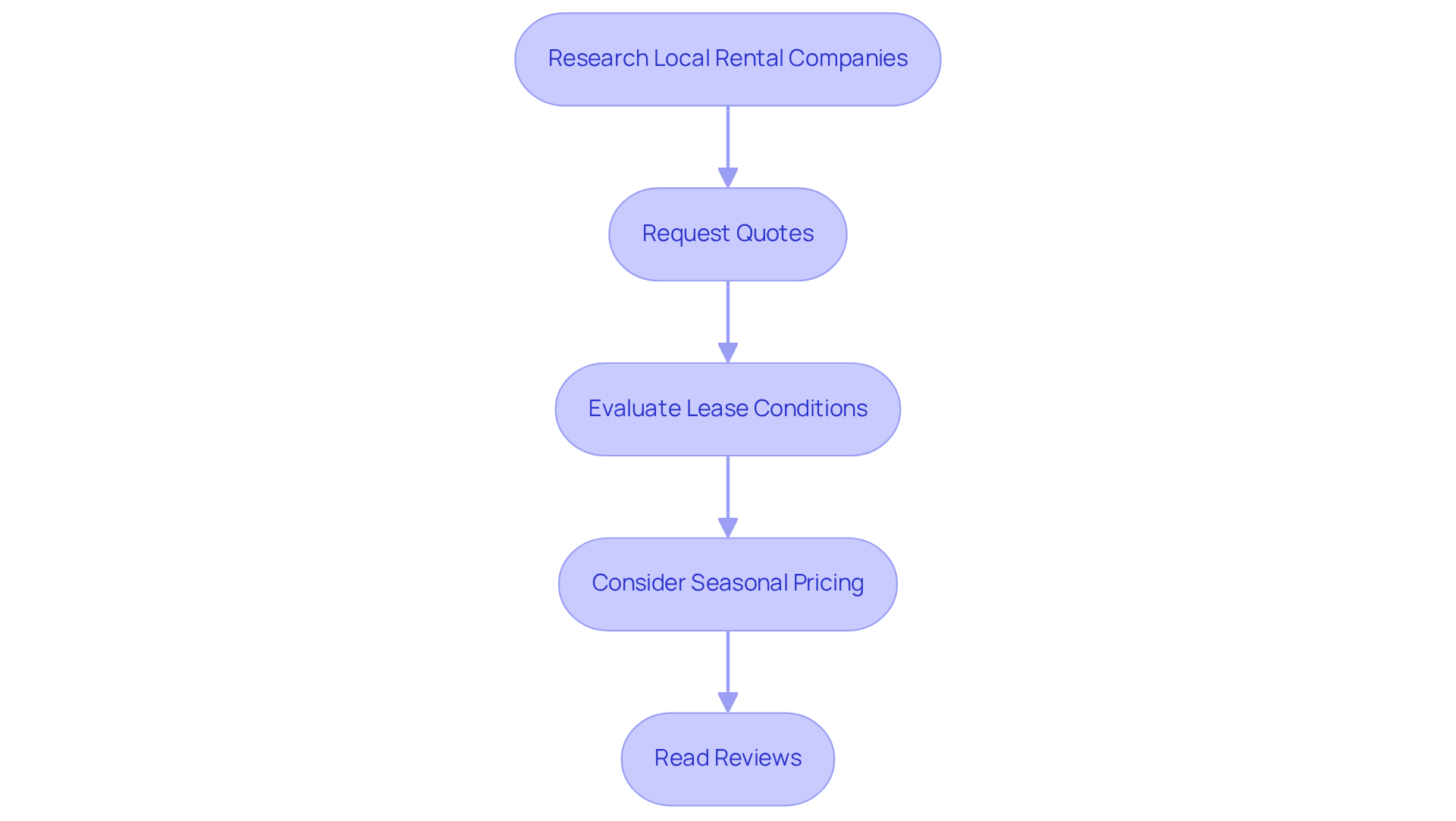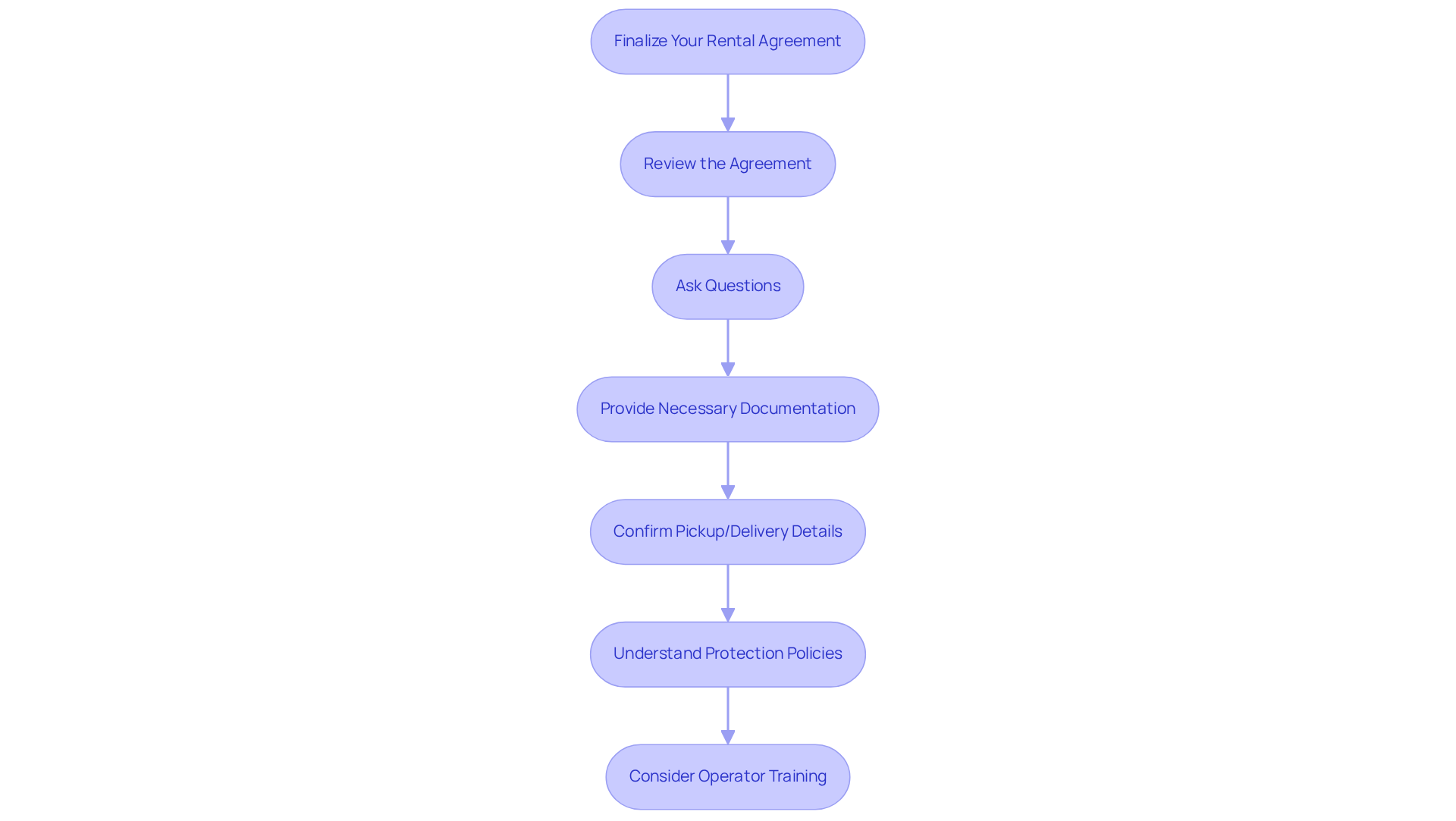Overview
Achieving success in heavy-duty flatbed trailer rental hinges on four essential steps:
- Assessing project requirements
- Evaluating trailer specifications
- Comparing rental options and pricing
- Finalizing the rental agreement
Each of these steps is vital, guiding the renter through a comprehensive understanding of their needs. This ensures that the right trailer is selected, competitive quotes are obtained, and a clear rental agreement is secured, effectively avoiding unexpected costs and complications.
Key Highlights:
- Assess project requirements by identifying materials to transport, travel distance, and loading/unloading needs to choose the right vehicle.
- Evaluate flatbed trailer specifications including weight capacity, dimensions, material quality, and additional features for optimal performance.
- Research local rental companies and obtain quotes, paying attention to additional costs and lease conditions to avoid unexpected expenses.
- Consider seasonal pricing variations and read customer reviews to gauge the reliability of rental services.
- Finalise the rental agreement by reviewing terms, asking questions, providing necessary documentation, confirming pickup/delivery details, and understanding protection policies.
Introduction
Navigating the world of heavy-duty flatbed trailer rentals presents significant challenges, particularly when the stakes are high and the loads are substantial. It is essential to grasp the intricacies of project requirements, trailer specifications, and rental agreements to ensure a seamless and successful experience. This guide outlines crucial steps designed to streamline the rental process, empowering readers to make informed decisions.
Consider the potential challenges that may arise from overlooking these critical factors; understanding how to effectively address them is key to avoiding costly mistakes.
Identify Your Project Requirements
Begin by thoroughly assessing the nature of your project. Consider the following critical questions:
-
What will you be transporting? Identify the type of materials or equipment you need to move. This will assist in identifying the suitable dimensions and weight capacity of the vehicle. For example, flatbed vehicles can carry a federal limit of 34,000 pounds for tandem axles, making them suitable for transporting heavy loads like lumber or machinery. Furthermore, flatbed vehicles can legally transport between 46,000 and 48,000 pounds, which is essential for grasping the capacity required for construction tasks.
-
How far will you be traveling? If your endeavor necessitates long-distance transport, choose a vehicle that provides improved stability and durability. Grasping the average weight capacity required for flatbed vehicles in construction projects is crucial, as it directly affects safety and adherence to towing regulations.
-
What are the loading and unloading requirements? Consider how you will load and unload the vehicle. Will you need ramps or specialized equipment? Evaluating these needs guarantees that you choose a vehicle that meets your operational requirements efficiently.
By gaining a clear understanding of your project requirements, you can confidently evaluate specifications and make informed decisions about a heavy duty flatbed trailer rental that enhance efficiency and safety in your operations. Remember, EZ Equipment Rental provides flexible rental terms and competitive pricing, especially for their heavy duty flatbed trailer rental, making it easier to access the right equipment for your needs.

Evaluate Flatbed Trailer Specifications
When evaluating a heavy duty flatbed trailer rental, it is essential to consider the following specifications to ensure optimal performance and reliability.
-
Weight Capacity: First and foremost, ensure the trailer can handle the weight of your load. Check the Gross Vehicle Weight Rating (GVWR) alongside the payload capacity to confirm it meets your needs.
-
Dimensions: Next, measure the length and width of the items you plan to transport. It is crucial that the vehicle's dimensions accommodate your load comfortably, allowing for safe transportation.
-
Material and Build Quality: Additionally, seek models constructed from robust materials that can endure the challenges of transportation. Steel and aluminum are common choices known for their durability and strength.
-
Features: Furthermore, consider additional attributes such as tie-down points, ramps, and side rails that may enhance the vehicle's functionality for your specific requirements.
By carefully evaluating these specifications for a heavy duty flatbed trailer rental, you can effectively narrow down your options and make an informed decision.

Compare Rental Options and Pricing
To effectively compare rental options and pricing for flatbed trailers, follow these essential steps:
-
Research Local Rental Companies: Start by identifying reputable rental companies in your area. For instance, EZ Equipment Rental is known for its reliability and exceptional customer service in the Dallas-Fort Worth area.
-
Request quotes by reaching out to multiple companies to obtain quotes for a heavy duty flatbed trailer rental that fits your specific requirements. Be sure to inquire about any additional costs, such as delivery fees or insurance, to avoid unexpected expenses.
-
Evaluate Lease Conditions: Carefully examine the lease conditions, paying close attention to the duration of the agreement, maintenance policies, and any penalties for late returns. Established construction teams often add a 10% or longer buffer to their estimated leasing duration, which can assist in planning. Understanding these details can help you avoid unnecessary expenses, as a heavy duty flatbed trailer rental with extended lease agreements typically results in lower daily rates.
-
Consider Seasonal Pricing: Recognize that seasonal demand can significantly influence rental pricing, with higher rates during peak construction seasons in spring and summer. By arranging your lease during off-peak times, you can achieve substantial savings.
-
Read Reviews: Investigate online feedback and testimonials to assess the reputation of the leasing services. Customer insights can provide valuable information regarding service quality and the condition of the equipment, enhancing your decision-making process.
By diligently comparing your options and considering these factors, you can make a well-informed decision that aligns with your budget and project requirements, ensuring a successful experience.

Finalize Your Rental Agreement
Once you have selected a leasing company and trailer, it is essential to finalize your leasing agreement with confidence. Follow these critical steps:
-
Review the Agreement: Carefully examine the rental agreement, ensuring that all terms align with your discussions, including pricing, rental duration, and any additional fees. Notably, statistics indicate that conflicts over leasing contracts are common in the equipment leasing sector, with approximately 30% of users experiencing misunderstandings about these specifics.
-
Ask Questions: Should anything be unclear, do not hesitate to seek clarification from the leasing company. Understanding every detail is vital to prevent unexpected surprises later on.
-
Provide Necessary Documentation: Be prepared to furnish identification and any required documentation, such as a driver's license or proof of insurance. This preparation can significantly expedite the leasing process and help avoid delays.
-
Confirm Pickup/Delivery Details: Ensure that you have verified the pickup or delivery date and time, along with any instructions for returning the trailer. Furthermore, inquire about the leasing firm's return policy to mitigate any unforeseen issues.
-
Understand Protection Policies: Familiarize yourself with the protection policies included in the leasing agreement, such as Loss-Damage Waivers (LDWs) and Equipment Protection (REP), which can limit your financial liability in the event of equipment loss or damage.
-
Consider Operator Training: If the equipment necessitates specific operational skills, check whether operator training is required and if the leasing company offers such training services.
By diligently following these steps, you can confidently finalize your rental agreement and set the stage for a successful rental experience.

Conclusion
Successfully renting a heavy-duty flatbed trailer is essential for ensuring that your project proceeds smoothly and efficiently. By clearly identifying your project requirements, evaluating trailer specifications, comparing rental options, and meticulously finalizing your rental agreement, you lay the groundwork for a successful rental experience. This comprehensive strategy not only boosts operational efficiency but also guarantees compliance with safety regulations.
Key considerations include:
- Assessing the type and weight of materials to be transported
- Understanding the necessary dimensions and features of the trailer
- Being vigilant about rental terms and pricing
Taking the time to research local rental companies and read customer reviews empowers you to make informed decisions that align with both your budget and project needs. Furthermore, thoroughly reviewing the rental agreement and clarifying any uncertainties will help prevent misunderstandings and unexpected costs.
Ultimately, the process of renting a heavy-duty flatbed trailer demands diligence and attention to detail. By embracing these steps, you simplify your rental experience while underscoring the importance of proper planning in achieving project success. Whether you are a seasoned contractor or a first-time renter, applying these insights will enhance your ability to navigate the complexities of trailer rental, ensuring that you have the right equipment to effectively meet your project goals.
Frequently Asked Questions
What should I consider when identifying my project requirements for transportation?
You should assess the nature of your project by considering what materials or equipment you will be transporting, how far you will be traveling, and your loading and unloading requirements.
What types of materials can flatbed vehicles transport?
Flatbed vehicles can transport heavy loads such as lumber or machinery, with a federal limit of 34,000 pounds for tandem axles and a legal transport capacity between 46,000 and 48,000 pounds.
Why is it important to know the distance of travel for transportation?
Knowing the distance of travel is crucial because it helps you choose a vehicle that provides improved stability and durability, which is essential for long-distance transport.
What should I evaluate regarding loading and unloading requirements?
You should consider whether you will need ramps or specialized equipment for loading and unloading the vehicle, ensuring that you select a vehicle that meets your operational needs efficiently.
How can understanding project requirements help in equipment rental decisions?
By gaining a clear understanding of your project requirements, you can confidently evaluate specifications and make informed decisions about renting a heavy-duty flatbed trailer that enhances efficiency and safety in your operations.
What rental options are available for heavy-duty flatbed trailers?
EZ Equipment Rental offers flexible rental terms and competitive pricing for their heavy-duty flatbed trailer rentals, making it easier to access the right equipment for your needs.




